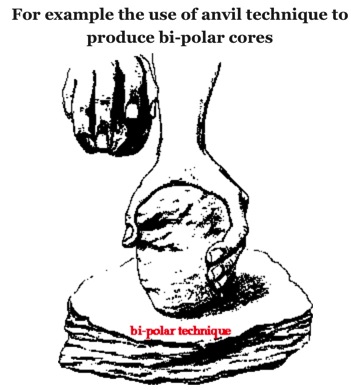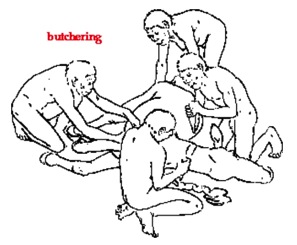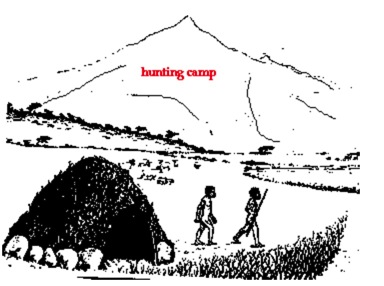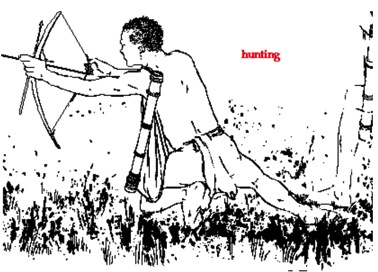This approach contrasts with the typological approach which concentrates on the end product alone as opposed to the whole process of lithic exploitation. Typology automatically produces a limited sample as only a very small percentage of pieces are retouched. The role of 'human choice' has become more important in understanding stone age sites, and one way of studying 'human choice' is through the chaîne opératoire approach. The operational sequence is from raw material procurement to primary reduction techniques (the reduction of nodules to cores), secondary reduction (the removal of blanks from cores and the manufacture off tools with retouch), the use of tools and the discard of the artifacts.
There are choices in the means of raw material exploitation. The material can be processed at source or transported as nodules, pre-formed cores or as finished products.
Technology is divided into Primary and Secondary reduction techniques and Typology.

Secondary reduction techniques include such aspects as blade and/or flake technology, use of hard or soft hammer, micro-burin technique, pressure flaking and the differences in retouch; both of placement (direct, inverse etc.) and type (abrupt, invasive etc.)


Function includes the specific use of tools, both of motion and worked materials (scraping bone, whittling wood etc.);

the identification of activities (hunting, hide processing etc.)

and the interpretation of site type (hunting camp, home base etc.).

The final stage is the discard of the material seen in knapping concentrations and clearance of areas with accompanying 'dump' areas.

Curation of tools would be included at this stage in that the removal of material from the site, for use elsewhere, constitutes a form of discard.
However the sequence includes feed-back loops in that, for example, the 'intended' use of tools will effect the choice of technology and raw material. For example if the intent is to make tanged points this will influence the choice of technology i.e. blade technology to produce suitable blanks.
If blade technology was 'chosen' then flint, as opposed to quartzite, may be procured. Also function need not be limited to utilitarian use. If it is intended to make a flint copy of a bronze dagger for a status or ritual function, this may influence the choice of raw material procurement to be trade in order to obtain large pieces of good quality flint with which to make such a dagger.
Thus the intended function of the tool can influence technology and the method of raw material procurement.
Intentionality also influences the various stages of technology. If a particular type is chosen e.g.. a truncation burin then burin technique will be used in the secondary reduction and blade technology in the primary reduction.

These choices made along the operational sequence may reflect different social structures and subsistence strategies employed during different periods. The different strategies are chosen from a number of possibilities as the preferred means of exploiting similar environmental resources.
It is the choice of strategy which characterizes the culture rather than simply the types of stone tools.
The chaîne opératoire approach to lithic analysis has mainly consisted of technological analysis of specific knapping procedures.The function of the tools has largely been ignored. Omitting function from the chaîne opératoire is to disregard the essential element, as knapping is carried out to produce tools. In use-wear analysis tools are used pieces whether retouched or not.
The chaîne opératoire approach is not a method but rather a framework within which different techniques (typological and technological analysis, re-fitting, use-wear analysis, spatial analysis etc.) can be used, depending on the particular research topic being examined.
Different theoretical positions can be applied and interpretations tested using this approach. Studying sites as dynamic processes rather than as static units provides a better foundation for understanding change in social groups.
Chaîne opératoire has mainly been used for the detailed reconstruction of reduction sequences by refitting. The emphasis has been on technological issues that are interpreted as reflecting the cognitive abilities of various cultures. (see Karlin and Julien 1994)
see movie on chaine operatoire
for a complete account of chaine operatoire see
Chaine Operatoire by Roger Grace published as an ebook by -
